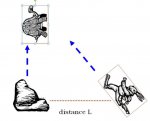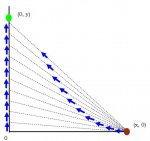Wow, those are nice diagrams. Clearly, you understand the given scenario.
May I ask? Does this exercise come from a Differential Equations course? There are much easier ways to model this. For example, one could simply prove that the hypotenuse in any right triangle is always longer than either leg.
I'm not sure what your class is doing here.
The position of the Tortoise at time t = y(t)
The position of the Hare in terms of the Tortoise = ycsc(t)
For the purposes of discussion, let's agree that the animals' rate is measured in feet/second.
If we pick symbol y(t) to represent the distance-traveled by the tortoise, and we define y(t)=t, then we have implicitly stated that the tortoise's rate is 1 foot per second. I think that it would be better to write a general definition for function y (i.e., use a symbolic rate) because that would lead to a model that works for any speed.
Symbol L needs to come into play, as well.
I do not understand what you wrote for the hare; ycsc(t) is not a function notation that I am familiar with. How do you define ycsc(t)?
The animal positions are (x,y) coordinates, and we can certainly calculate distance from one point to another using the coordinates of the two points. That is, we could express the straight-line distance from the hare to the tortoise at any time t. If that expression can never reach zero, then we've proved that the hare can never reach the tortoise.
Anyway -- please confirm whether this exercise comes from a differential equations course; and, if it does, please post the exercise statement verbatim.
Cheers :cool:


